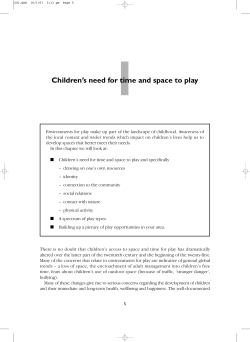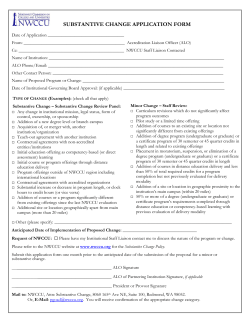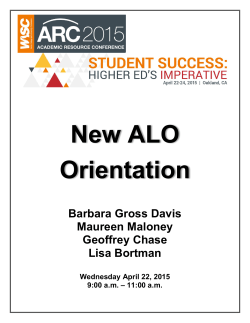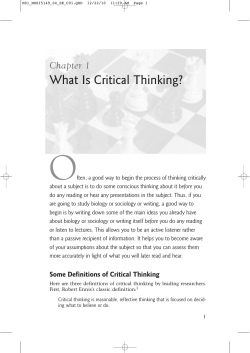
Working with adjacent line open: Dr Liesel von Metz
Working with adjacent line open: how to get it right Dr Liesel von Metz HM Inspector of Railways Office of Rail Regulation 1 “Adjacent Line Open” (ALO) Working ! Working next to one or more open lines of railway ! Can be 1 or 2 lines blocked out of 4...... ! One of 2 lines blocked (previously “single line working”) 2 ALO Working: Characteristics ! Frequently tight clearances ! Blocks may be short, often at night, delayed ! Midweek nights- 4 to 7 hours ! Weekends- 36 to 48 hours ! Limited locations for access, long Worksites ! Isolation of OHLE might not match line block patterns ! There is a cost associated with ALO working.... Do lower Schedule 4 & 8 payments offset that? 3 ALO Working: Characteristics 4 ALO Working: Characteristics 5 ALO Working: principles of control ! Risk to passing trains from RRVs, cranes etc ! Block the open line at times when RRVs could be foul ! Limit the movement of the RRV/crane so it cannot become foul ! Speed limit of 20mph or 40 mph is not a control measure- but can be a comfort factor for Drivers and the workforce ! Risk to workforce from passing trains (and RRVs) ! Barrier to separate the workforce from trains and/or a means of warning the workforce trains are passing 6 ALO Working: History 7 How to do safe ALO working? ! ALO working can be done safely if we take into account the “3-ologies”: ! Technology- the useful gizmos ! Methodology- how the gizmos are used ! Psychology- the challenge of human unreliability ! The principles remain the same but each site and job has specific characteristics 8 Technology: keeping the workforce safe Magnetic fencing Vortok fencing, ATWS 9 Technology: taking line blockages efficiently 10 Technology: Movement Limiting Devices Slew Limitation What is “reliable”? Maintenance? 11 Technology: Movement Limiting Devices “Virtual Wall” concept What is “reliable”? 12 Technology: Movement Limiting devices GKD “Spaceguard” How does CC know it is set? 13 Future technology: challenges to address ! How do we constrain the base of an RRV that is not in rail mode so we can control it in the dig? ! Concept of a laser to define the datum for the machine base ! Emergency stop systems for non-slewing plant (dozers) ! Physical barriers have limited use in Track renewals ! Gateway systems- is there a place for using temporary TPWS as an emergency train-stop? ! Speed-activated TSR reminder boards, personal alarms- solutions looking for a problem? 14 Methodology: Planning the job ! Plans need to reflect reality- as it is on the ground ! Different activities during the job might need different control measures- panelling out, digging/dozing, sleeper-laying, thimbling new rail in ! Engaging the supply chain: engineering train consist, specific type of RRV or crane, maintenance and reliability ! Contingency planning- “stuff happening” and an over-run does not mean it is OK to reduce the level of risk control ! Alternative methods 15 Methodology: Thoughts on planning ! Are the work rates with a RRV using “Spaceguard” on it as fast as without......? ! Are your contingency options limited (e.g. if installing modular S&C cannot revert to skim-dig)? ! How likely it is the block will be granted on time? ! Is there a “boat train” that is often late? ! Does this Route struggle with resourcing isolation staff? ! Do you know where the foul line is throughout the site? 16 Methodology: Engaging with the Route 17 Methodology: Implementation ! Communication and competence ! Who is in charge? ! Do they know what is going on...? ! Shift changes and changes in block pattern ! Late Changes ! Location of foul line ! Monitoring: “what gets checked gets done” 18 Methodology: Contingency management ! Identify and eliminate predictable failure modes ! RRV failures: is the supplier being paid enough to carry out the higher level of maintenance of MLDs required? ! Does the expected work-rate impact on components ! Decisions ideally involve all stakeholders, pulling together- Route Control, contractors, suppliers, TOCs ! Way out of the hole should maintain risk controls ! Do we need “CRM” for Track Renewals? 19 Psychology: dealing with human fraility ! People are not 100% reliable and never will be ! Rule-driven culture, “NRB” fears, weekend warriors ! Developing and retaining competence is important ! Root cause analysis rather than blame ! Environment: time pressure, dark, cold, wet, tired ! What behaviours do we recognise/reward? ! Work needs to be planned so it is achievable for someone other than Superman 20 Conclusions ! ALO working can be done safely and effectively ! Sound planning and collaboration are critical ! Innovation is not just about gizmos- it’s also about soft skills, behaviours and getting people to pull together ! Technology is a tool not a magic wand- the right solution in the right place at the right time ! Integrate the “3-ologies”- technology, methodology and psychology 21 Successful ALO working 22 Questions? 23
© Copyright 2025





















